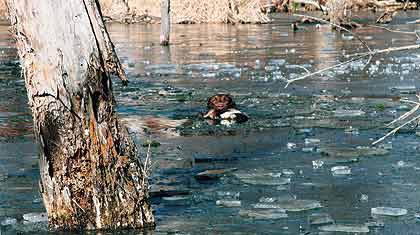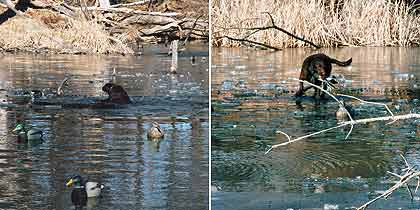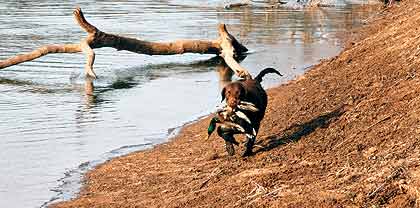Kayla's initial hunt was entertaining but the ducks did not cooperate, so we headed north with little experience and high hopes.
By Gary Koehler
My Chesapeake Bay retriever Kayla's first real duck hunt, which took place in south-central Missouri when she was not yet two years old, was something of a debacle. A friend had provided me an invitation to join him to hunt a flooded field. The shooting, he said, had been extraordinary the previous week.
 Practical experience, some say, arrives shortly after one needs it. This can be said of many ventures, including retriever training. The words of wisdom are applicable to both the dog and the handler. |
We loaded our gear into the car, drove more than three hours, met up with our host and two friends, and spent the night in a motel plotting strategy. The weatherman provided a hint that we might be in for a long day when he predicted the temperature would drop into the teens overnight.
Sure enough, the rice field was locked up tight with ice. We opened a hole, unloaded the gear, and were setting decoys when a hen mallard flew out from under the blind, which was positioned up against the levee. It was the only duck we saw all day. And it was probably the last time Kayla will ever witness that particularly confounding waterfowl escape.
This was an inauspicious start for my pup, who that morning was forced to be content making a pest of herself in the blind, taking long walks along the dike, and busying herself gnawing chunks of ice. The next day, at a different location, provided the same scenario.
Kayla had to be wondering why she had been required to retrieve literally hundreds of training bumpers on land and water. She had to be wondering why we had spent countless hours on backyard obedience. For what? To ice skate?
This was my duck dog. I had acquired Kayla to accompany me on duck hunts. She had a job. And so did I. So far, I had not held up my portion of the partnership.
Last fall we headed north to Illinois, the home state for both of us. I made arrangements to meet up with two long-time friends, Paul Gillmann and Kenny Pozzi, with whom I had hunted for years in the Illinois River Valley. They were members of a small duck hunting club. Weekdays at the club were generally quiet. A plan was in the works.
"Will she retrieve a duck?" Pozzi asked shortly after Kayla and I arrived.
I told him I couldn't be sure. I explained that we had put in plenty of preparation time, but that Kayla's in-the-field experience was limited.
The next morning was unseasonably warm. No ducks. So we worked on her retrieving hand-tossed dummies in one of the club's gunning holes. Maybe tomorrow would be better.
And it was. A few minutes after shooting time, three mallards circled the decoys. I was positioned kneeling outside the huge wooden box blind, Kayla on lead.
Gillmann fired. The roar from inside the blind startled Kayla, and she bolted, pulling me over on my back. Not having seen the ducks in the air, and being unaware of the source of the loud noise, she was ready to head for the timber.
At first, I was angry, because she refused to listen. She simply wanted to get out of there and was doing her darnedest to do just that. Then I realized that I had screwed up again. I clearly had not spent enough time with her around live gunfire. Some, yes, but not nearly enough.
 Kayla quickly figured out how to negotiate the ice...and deliver the goods. |
She was spooked. Knowing gunshyness is not the easiest thing in the world to correct or cure, I was hesitant to stick around. I did not want things to worsen.
Kayla reacted the same way during the next round of gunshots. But there were a couple of ducks on the water this time, and once she calmed down, I sent her after a downed mallard drake. She entered the water, looked around, and swam after the crippled duck. She then returned the bird to me.
A second mallard had crept out of the water into tall grass at the edge of the pond. The bird was now hiding and invisible. I took Kayla with me to where the duck had exited the pond and hoped she would pick up the scent. Two minutes later, she popped out of the weeds, duck in her mouth.
The morning flight was over by 10 o'clock. No more shots were fired.
All the way home--and I had nearly a 10-hour ride to fret over it-- I worried about Kayla's adverse reaction to the booming shotguns. True, she had not known what was coming. She was surprised. And, the echo from inside the blind magnified the sound. Had I ruined my dog by skimping on introducing her to gunfire?
That question was answered about six weeks later in northern Oklahoma. We were on another road trip. My host said that he had been enjoying excellent gunning. That sounded great. But the temperature dipped to 22 degrees overnight. And the timber hole we were to hunt was covered with more than an inch of ice. Here we go again, I thought.
Ice was broken. Decoys were deployed. And Kayla and I hunkered down alongside a scrub tree. Cover was at a minimum. I initially did not take my gun out of its case. A duck call rang out, and Kayla sat watching. The mallards wanted no part of it. The call rang again. This time, gadwalls answered, feet down.
Five shots roared. Three ducks fell. Kayla didn't budge. The gunfire did not scare her this time. She had seen the ducks in the air. She had become used to the sound of the duck call. No problem.
I released Kayla from her lead. She was unsure where to go first, into the water, or to the bird lying on the ground at the edge of the pond. One at a time, she picked up the birds. And brought them to me. Not in picture-book fashion. Not perfect. Not particularly stylish. But she acted like she knew why she was there.
The rest of the morning played out much the same. Gadwalls, mallards, and green-winged teal made up the bag--19 ducks in all. Kayla retrieved all but two.
She got an expanded education that morning. Ice was foreign to her. But she made her way, swimming in the cold water. Picking her way across the ice. Banging her chest against the
ice in an effort to reach a downed bird just out of her reach.
 Kayla brings in a mallard. |
"When she saw that first bird hit the ground and marked it, she had it," said Elmo Halverson, who had hunted with a Chessie for a dozen years. "The more she's out here, the more she's going to learn. You can teach dogs so much, but they learn by getting out and actually doing it. It's all about experience."
The next day provided different terrain and another lesson. We were set up along the bank of a small river. The water was little over knee deep, but there was a steady current.
Kayla and I sat halfway up the bank. The view was panoramic. She could see the birds flying down river, watch the shooters in front of us and mark the birds clearly. I was determined to keep her under control, and maintained her on lead. When the birds fell, I released her. She retrieved 18 of the 22 ducks killed.
"She's retrieved more ducks the last two days than some dogs do in a season," said Art Ladehoff of Big Foot Decoy fame, and another former Chessie owner. "If anything, she's probably gotten spoiled."
True, because by the end of that second day, she welcomed the gunfire, if only because she had learned that it was a signal for her to get ready to go to work. I was lucky. Gunshyness did not turn out to be an issue.
This season, I'm going to have to work extra hard on maintaining my end of the partnership. Because if I don't shoot well, Kayla's going to be more than a little disappointed. And we can't have that.






